
redisvl
Redis Vector Library (RedisVL) enables Redis as a realtime vector database for LLM Applications.
Stars: 158
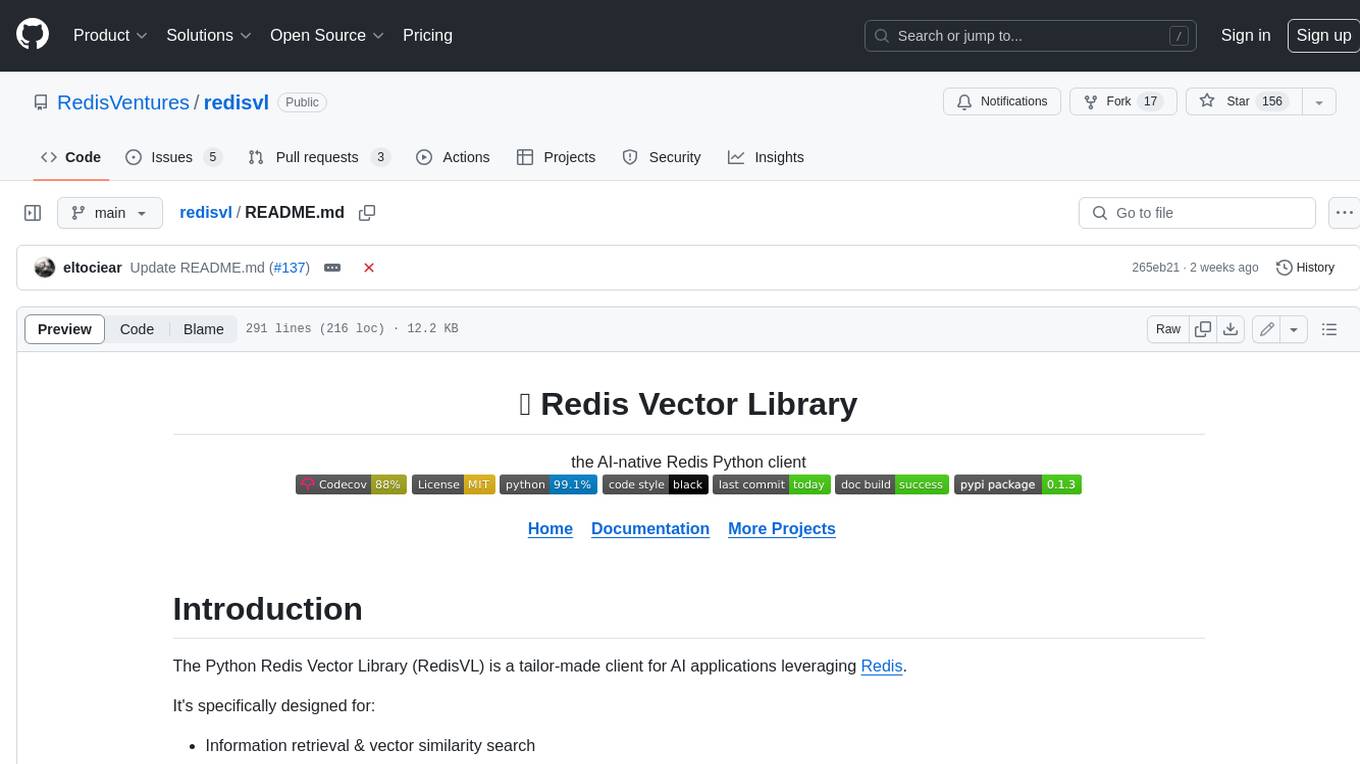
Redis Vector Library (RedisVL) is a Python client library for building AI applications on top of Redis. It provides a high-level interface for managing vector indexes, performing vector search, and integrating with popular embedding models and providers. RedisVL is designed to make it easy for developers to build and deploy AI applications that leverage the speed, flexibility, and reliability of Redis.
README:
The Python Redis Vector Library (RedisVL) is a tailor-made client for AI applications leveraging Redis.
It's specifically designed for:
- Information retrieval & vector similarity search
- Real-time RAG pipelines
- Recommendation engines
Enhance your applications with Redis' speed, flexibility, and reliability, incorporating capabilities like vector-based semantic search, full-text search, and geo-spatial search.
The emergence of the modern GenAI stack, including vector databases and LLMs, has become increasingly popular due to accelerated innovation & research in information retrieval, the ubiquity of tools & frameworks (e.g. LangChain, LlamaIndex, EmbedChain), and the never-ending stream of business problems addressable by AI.
However, organizations still struggle with delivering reliable solutions quickly (time to value) at scale (beyond a demo).
Redis has been a staple for over a decade in the NoSQL world, and boasts a number of flexible data structures and processing engines to handle realtime application workloads like caching, session management, and search. Most notably, Redis has been used as a vector database for RAG, as an LLM cache, and chat session memory store for conversational AI applications.
The vector library bridges the gap between the emerging AI-native developer ecosystem and the capabilities of Redis by providing a lightweight, elegant, and intuitive interface. Built on the back of the popular Python client, redis-py, it abstracts the features Redis into a grammar that is more aligned to the needs of today's AI/ML Engineers or Data Scientists.
Install redisvl into your Python (>=3.8) environment using pip:
pip install redisvlFor more instructions, visit the
redisvlinstallation guide.
Choose from multiple Redis deployment options:
- Redis Cloud: Managed cloud database (free tier available)
-
Redis Stack: Docker image for development
docker run -d --name redis-stack -p 6379:6379 -p 8001:8001 redis/redis-stack:latest
- Redis Enterprise: Commercial, self-hosted database
- Azure Cache for Redis Enterprise: Fully managed Redis Enterprise on Azure
Enhance your experience and observability with the free Redis Insight GUI.
-
Design an
IndexSchemathat models your dataset with built-in Redis data structures (Hash or JSON) and indexable fields (e.g. text, tags, numerics, geo, and vectors).Load a schema from a YAML file:
index: name: user-index-v1 prefix: user storage_type: json fields: - name: user type: tag - name: credit_score type: tag - name: embedding type: vector attrs: algorithm: flat dims: 3 distance_metric: cosine datatype: float32
from redisvl.schema import IndexSchema schema = IndexSchema.from_yaml("schemas/schema.yaml")
Or load directly from a Python dictionary:
schema = IndexSchema.from_dict({ "index": { "name": "user-index-v1", "prefix": "user", "storage_type": "json" }, "fields": [ {"name": "user", "type": "tag"}, {"name": "credit_score", "type": "tag"}, { "name": "embedding", "type": "vector", "attrs": { "algorithm": "flat", "datatype": "float32", "dims": 4, "distance_metric": "cosine" } } ] })
-
Create a SearchIndex class with an input schema and client connection in order to perform admin and search operations on your index in Redis:
from redis import Redis from redisvl.index import SearchIndex # Establish Redis connection and define index client = Redis.from_url("redis://localhost:6379") index = SearchIndex(schema, client) # Create the index in Redis index.create()
Async compliant search index class also available:
AsyncSearchIndex -
Load and fetch data to/from your Redis instance:
data = {"user": "john", "credit_score": "high", "embedding": [0.23, 0.49, -0.18, 0.95]} # load list of dictionaries, specify the "id" field index.load([data], id_field="user") # fetch by "id" john = index.fetch("john")
Define queries and perform advanced searches over your indices, including the combination of vectors, metadata filters, and more.
-
VectorQuery - Flexible vector queries with customizable filters enabling semantic search:
from redisvl.query import VectorQuery query = VectorQuery( vector=[0.16, -0.34, 0.98, 0.23], vector_field_name="embedding", num_results=3 ) # run the vector search query against the embedding field results = index.query(query)
Incorporate complex metadata filters on your queries:
from redisvl.query.filter import Tag # define a tag match filter tag_filter = Tag("user") == "john" # update query definition query.set_filter(tag_filter) # execute query results = index.query(query)
-
RangeQuery - Vector search within a defined range paired with customizable filters
-
FilterQuery - Standard search using filters and the full-text search
-
CountQuery - Count the number of indexed records given attributes
Read more about building advanced Redis queries here.
Create, destroy, and manage Redis index configurations from a purpose-built CLI interface: rvl.
$ rvl -h
usage: rvl <command> [<args>]
Commands:
index Index manipulation (create, delete, etc.)
version Obtain the version of RedisVL
stats Obtain statistics about an indexRead more about using the
redisvlCLI here.
Integrate with popular embedding models and providers to greatly simplify the process of vectorizing unstructured data for your index and queries:
from redisvl.utils.vectorize import CohereTextVectorizer
# set COHERE_API_KEY in your environment
co = CohereTextVectorizer()
embedding = co.embed(
text="What is the capital city of France?",
input_type="search_query"
)
embeddings = co.embed_many(
texts=["my document chunk content", "my other document chunk content"],
input_type="search_document"
)Learn more about using
redisvlVectorizers in your workflows here.
In order to perform well in production, modern GenAI applications require much more than vector search for retrieval. redisvl provides some common extensions that
aim to improve applications working with LLMs:
-
LLM Semantic Caching is designed to increase application throughput and reduce the cost of using LLM models in production by leveraging previously generated knowledge.
from redisvl.extensions.llmcache import SemanticCache # init cache with TTL (expiration) policy and semantic distance threshhold llmcache = SemanticCache( name="llmcache", ttl=360, redis_url="redis://localhost:6379" ) llmcache.set_threshold(0.2) # can be changed on-demand # store user queries and LLM responses in the semantic cache llmcache.store( prompt="What is the capital city of France?", response="Paris", metadata={} ) # quickly check the cache with a slightly different prompt (before invoking an LLM) response = llmcache.check(prompt="What is France's capital city?") print(response[0]["response"])
>>> "Paris"Learn more about Semantic Caching here.
-
LLM Session Management (COMING SOON) aims to improve personalization and accuracy of the LLM application by providing user chat session information and conversational memory.
-
LLM Contextual Access Control (COMING SOON) aims to improve security concerns by preventing malicious, irrelevant, or problematic user input from reaching LLMs and infrastructure.
To get started, check out the following guides:
Please help us by contributing PRs, opening GitHub issues for bugs or new feature ideas, improving documentation, or increasing test coverage. Read more about how to contribute!
This project is supported by Redis, Inc on a good faith effort basis. To report bugs, request features, or receive assistance, please file an issue.
For Tasks:
Click tags to check more tools for each tasksFor Jobs:
Alternative AI tools for redisvl
Similar Open Source Tools

redisvl
Redis Vector Library (RedisVL) is a Python client library for building AI applications on top of Redis. It provides a high-level interface for managing vector indexes, performing vector search, and integrating with popular embedding models and providers. RedisVL is designed to make it easy for developers to build and deploy AI applications that leverage the speed, flexibility, and reliability of Redis.
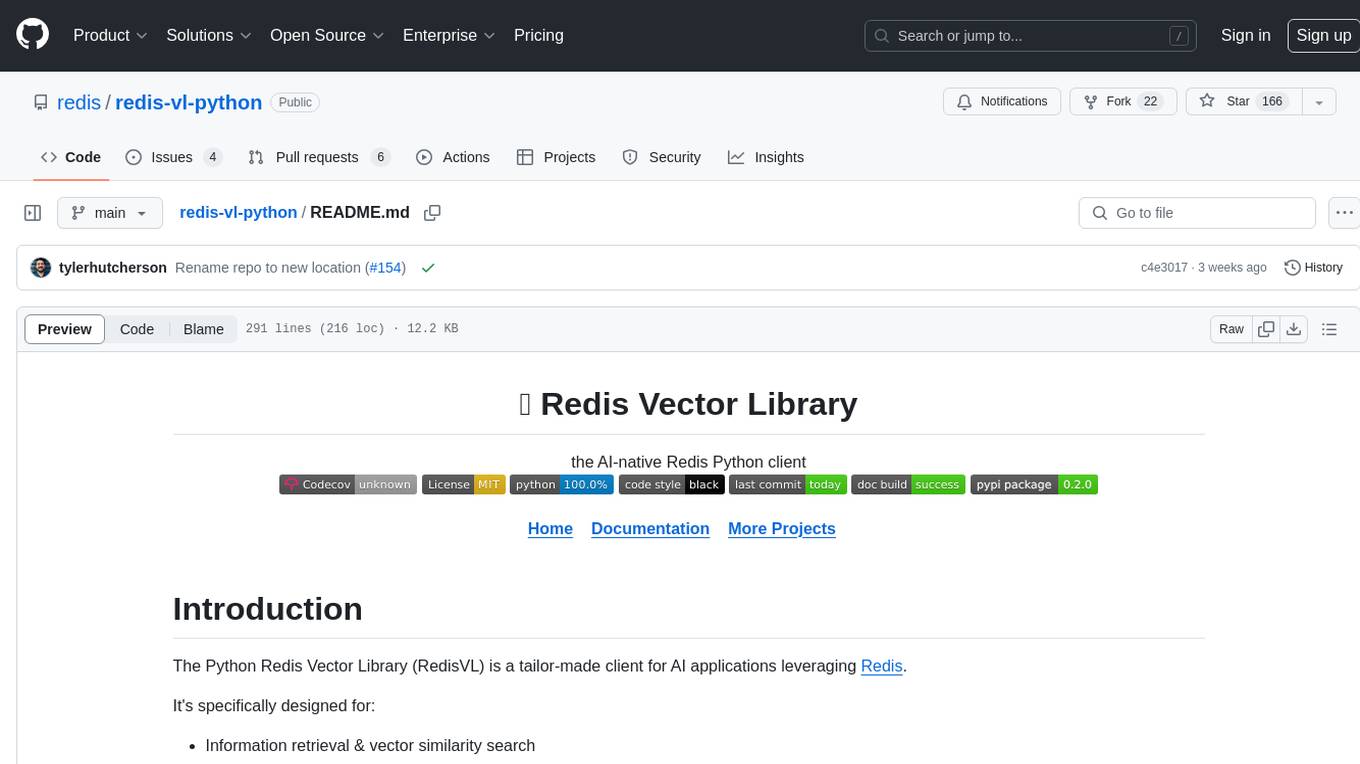
redis-vl-python
The Python Redis Vector Library (RedisVL) is a tailor-made client for AI applications leveraging Redis. It enhances applications with Redis' speed, flexibility, and reliability, incorporating capabilities like vector-based semantic search, full-text search, and geo-spatial search. The library bridges the gap between the emerging AI-native developer ecosystem and the capabilities of Redis by providing a lightweight, elegant, and intuitive interface. It abstracts the features of Redis into a grammar that is more aligned to the needs of today's AI/ML Engineers or Data Scientists.

req_llm
ReqLLM is a Req-based library for LLM interactions, offering a unified interface to AI providers through a plugin-based architecture. It brings composability and middleware advantages to LLM interactions, with features like auto-synced providers/models, typed data structures, ergonomic helpers, streaming capabilities, usage & cost extraction, and a plugin-based provider system. Users can easily generate text, structured data, embeddings, and track usage costs. The tool supports various AI providers like Anthropic, OpenAI, Groq, Google, and xAI, and allows for easy addition of new providers. ReqLLM also provides API key management, detailed documentation, and a roadmap for future enhancements.

golf
Golf is a simple command-line tool for calculating the distance between two geographic coordinates. It uses the Haversine formula to accurately determine the distance between two points on the Earth's surface. This tool is useful for developers working on location-based applications or projects that require distance calculations. With Golf, users can easily input latitude and longitude coordinates and get the precise distance in kilometers or miles. The tool is lightweight, easy to use, and can be integrated into various programming workflows.
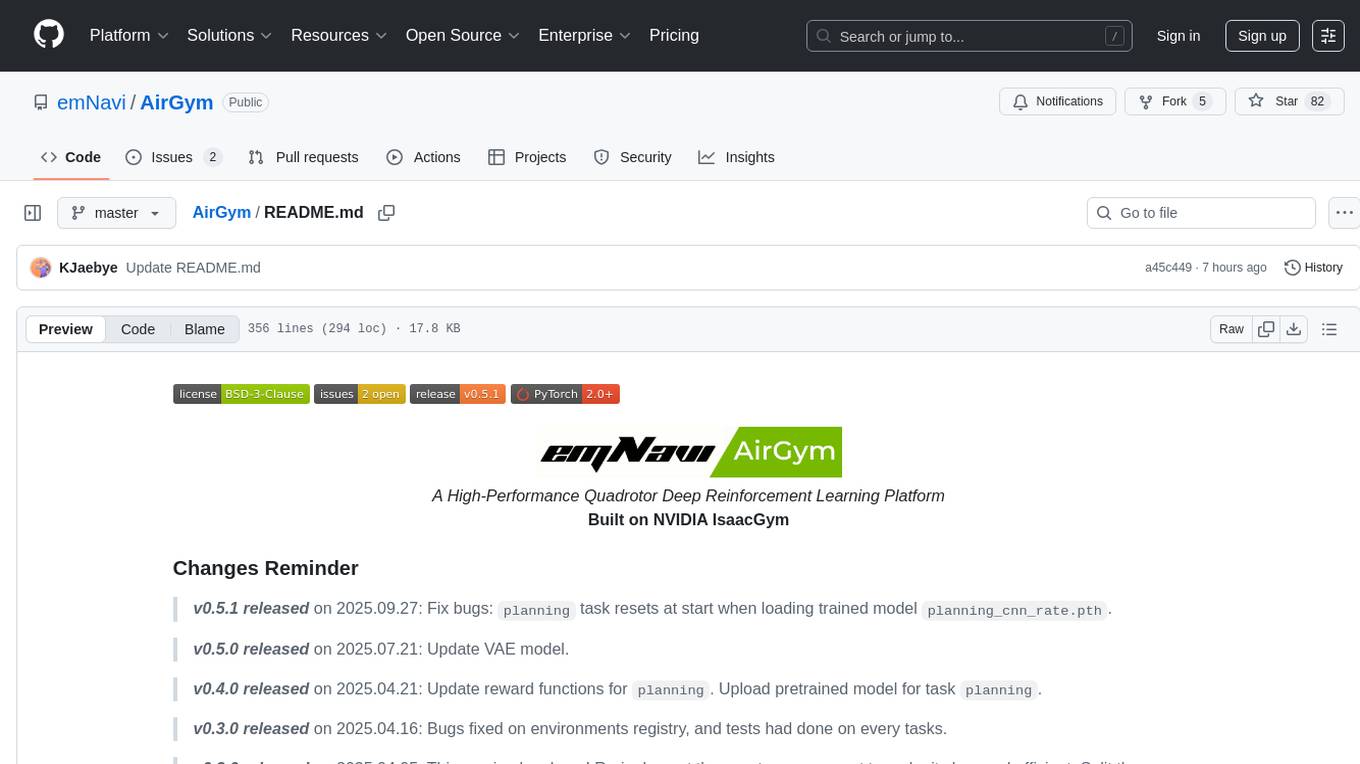
AirGym
AirGym is an open source Python quadrotor simulator based on IsaacGym, providing a high-fidelity dynamics and Deep Reinforcement Learning (DRL) framework for quadrotor robot learning research. It offers a lightweight and customizable platform with strict alignment with PX4 logic, multiple control modes, and Sim-to-Real toolkits. Users can perform tasks such as Hovering, Balloon, Tracking, Avoid, and Planning, with the ability to create customized environments and tasks. The tool also supports training from scratch, visual encoding approaches, playing and testing of trained models, and customization of new tasks and assets.
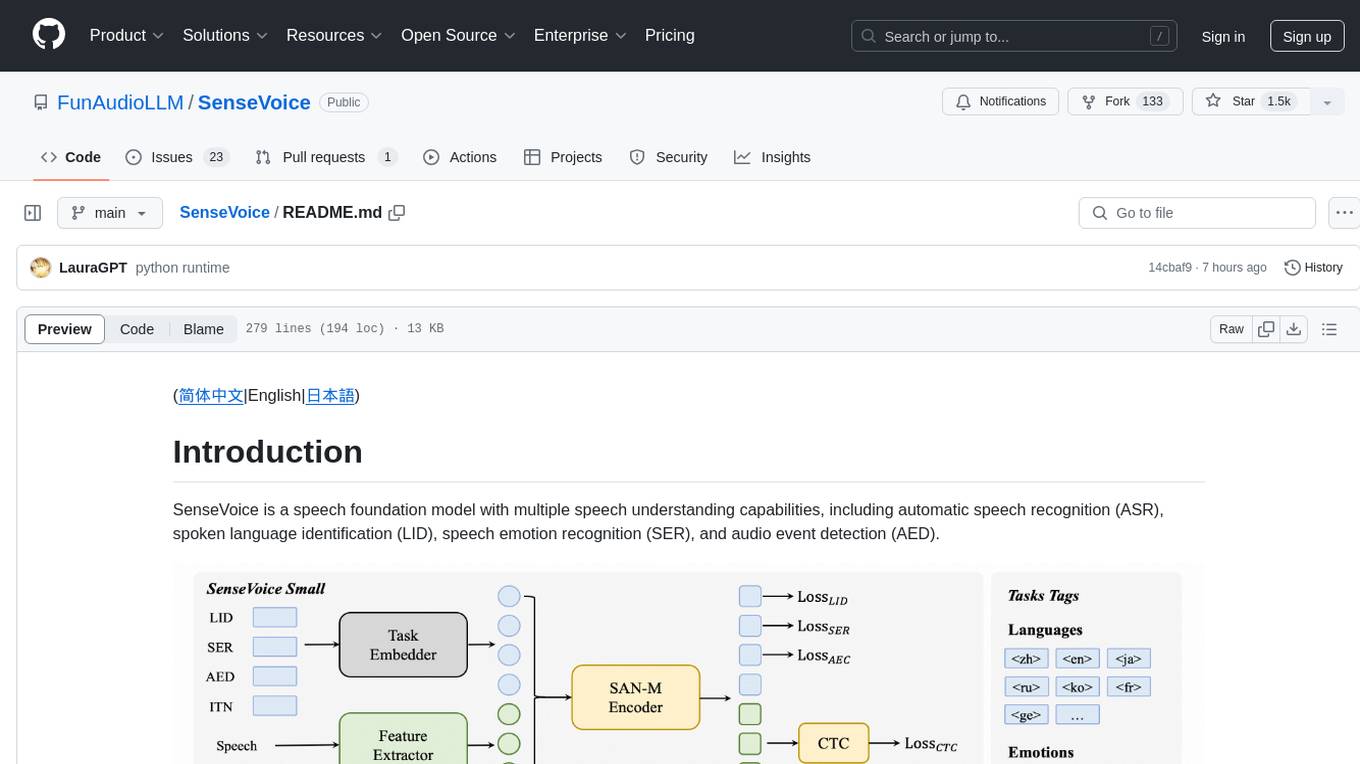
SenseVoice
SenseVoice is a speech foundation model focusing on high-accuracy multilingual speech recognition, speech emotion recognition, and audio event detection. Trained with over 400,000 hours of data, it supports more than 50 languages and excels in emotion recognition and sound event detection. The model offers efficient inference with low latency and convenient finetuning scripts. It can be deployed for service with support for multiple client-side languages. SenseVoice-Small model is open-sourced and provides capabilities for Mandarin, Cantonese, English, Japanese, and Korean. The tool also includes features for natural speech generation and fundamental speech recognition tasks.
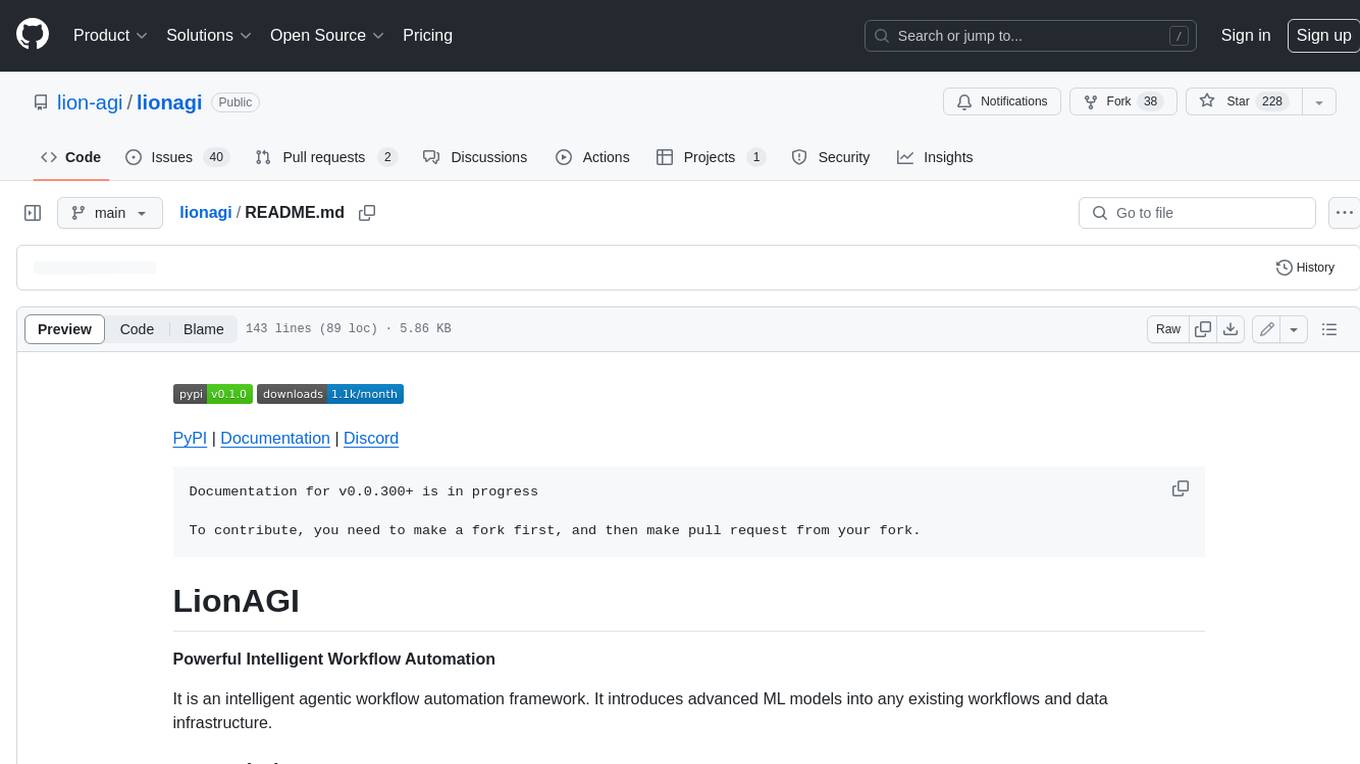
lionagi
LionAGI is a powerful intelligent workflow automation framework that introduces advanced ML models into any existing workflows and data infrastructure. It can interact with almost any model, run interactions in parallel for most models, produce structured pydantic outputs with flexible usage, automate workflow via graph based agents, use advanced prompting techniques, and more. LionAGI aims to provide a centralized agent-managed framework for "ML-powered tools coordination" and to dramatically lower the barrier of entries for creating use-case/domain specific tools. It is designed to be asynchronous only and requires Python 3.10 or higher.
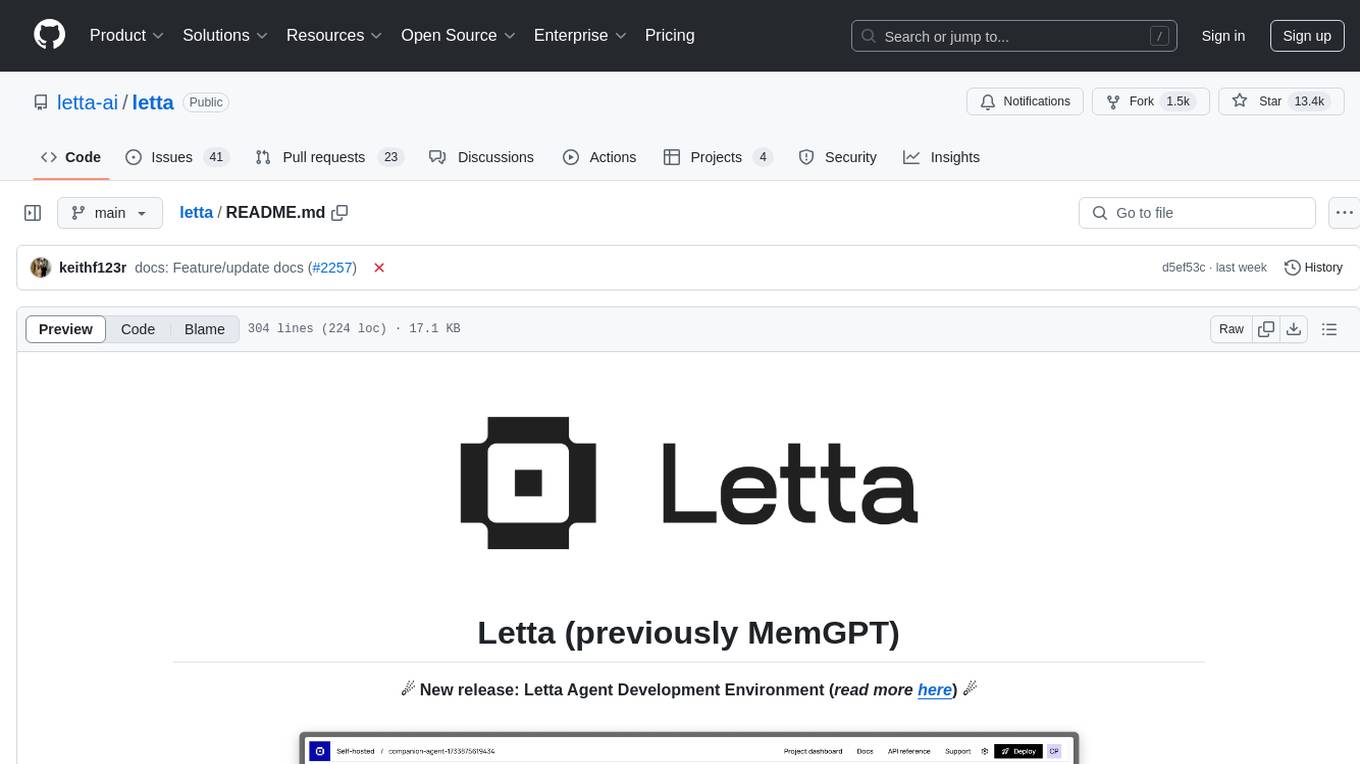
letta
Letta is an open source framework for building stateful LLM applications. It allows users to build stateful agents with advanced reasoning capabilities and transparent long-term memory. The framework is white box and model-agnostic, enabling users to connect to various LLM API backends. Letta provides a graphical interface, the Letta ADE, for creating, deploying, interacting, and observing with agents. Users can access Letta via REST API, Python, Typescript SDKs, and the ADE. Letta supports persistence by storing agent data in a database, with PostgreSQL recommended for data migrations. Users can install Letta using Docker or pip, with Docker defaulting to PostgreSQL and pip defaulting to SQLite. Letta also offers a CLI tool for interacting with agents. The project is open source and welcomes contributions from the community.

weave
Weave is a toolkit for developing Generative AI applications, built by Weights & Biases. With Weave, you can log and debug language model inputs, outputs, and traces; build rigorous, apples-to-apples evaluations for language model use cases; and organize all the information generated across the LLM workflow, from experimentation to evaluations to production. Weave aims to bring rigor, best-practices, and composability to the inherently experimental process of developing Generative AI software, without introducing cognitive overhead.
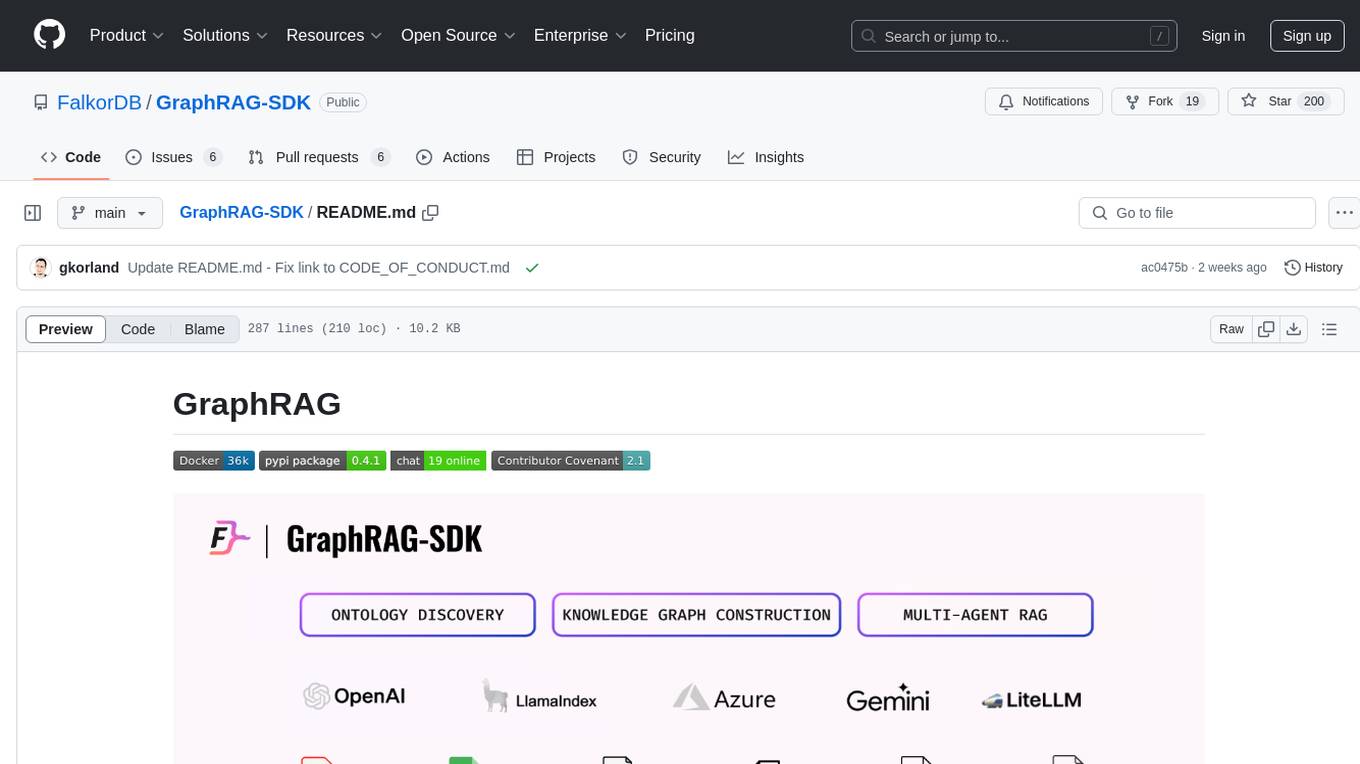
GraphRAG-SDK
Build fast and accurate GenAI applications with GraphRAG SDK, a specialized toolkit for building Graph Retrieval-Augmented Generation (GraphRAG) systems. It integrates knowledge graphs, ontology management, and state-of-the-art LLMs to deliver accurate, efficient, and customizable RAG workflows. The SDK simplifies the development process by automating ontology creation, knowledge graph agent creation, and query handling, enabling users to interact and query their knowledge graphs effectively. It supports multi-agent systems and orchestrates agents specialized in different domains. The SDK is optimized for FalkorDB, ensuring high performance and scalability for large-scale applications. By leveraging knowledge graphs, it enables semantic relationships and ontology-driven queries that go beyond standard vector similarity, enhancing retrieval-augmented generation capabilities.
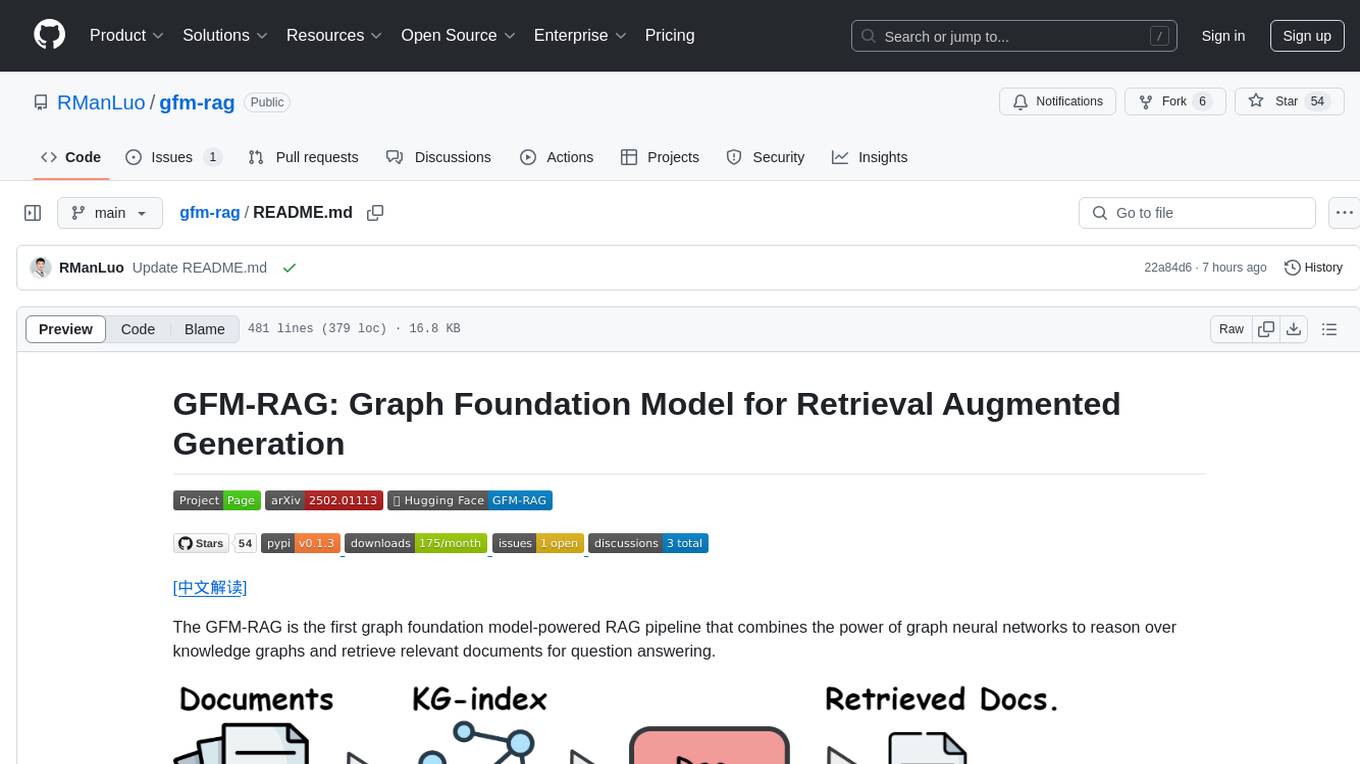
gfm-rag
The GFM-RAG is a graph foundation model-powered pipeline that combines graph neural networks to reason over knowledge graphs and retrieve relevant documents for question answering. It features a knowledge graph index, efficiency in multi-hop reasoning, generalizability to unseen datasets, transferability for fine-tuning, compatibility with agent-based frameworks, and interpretability of reasoning paths. The tool can be used for conducting retrieval and question answering tasks using pre-trained models or fine-tuning on custom datasets.
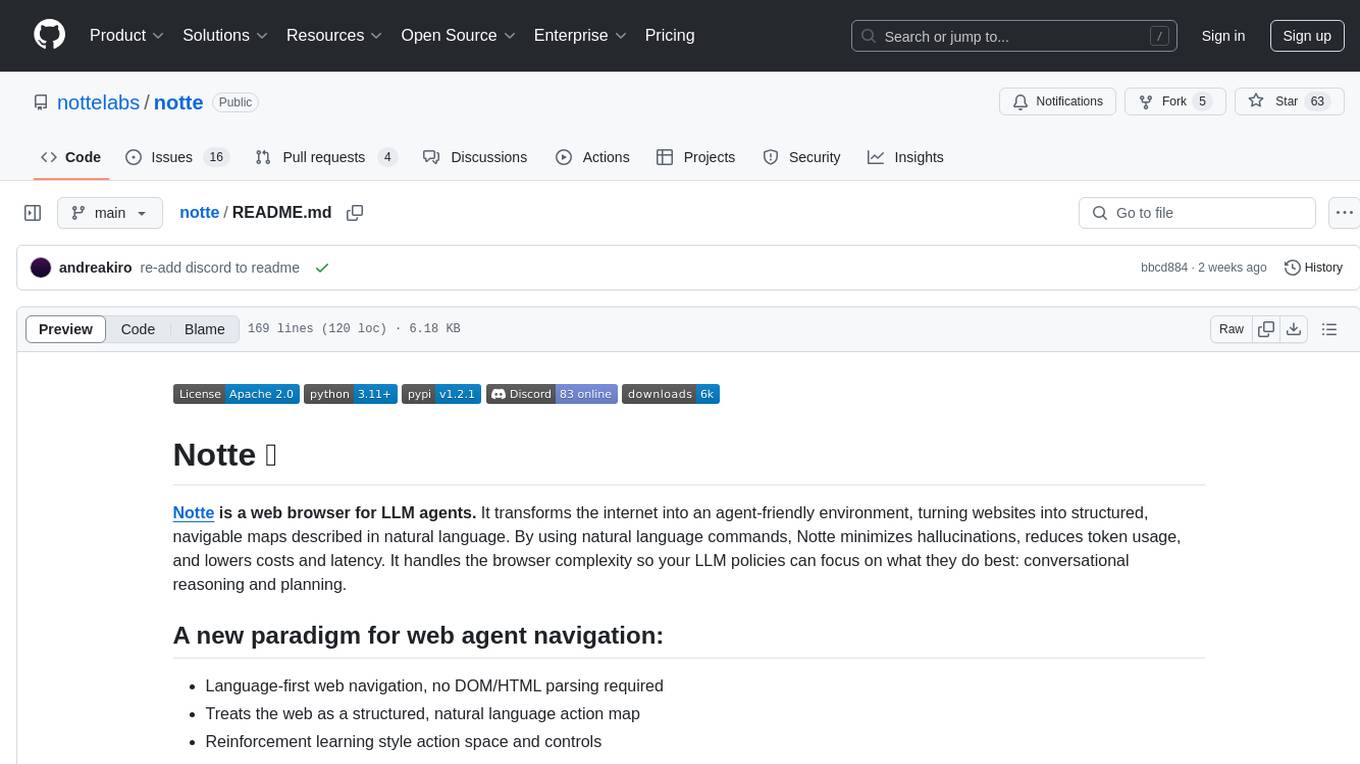
notte
Notte is a web browser designed specifically for LLM agents, providing a language-first web navigation experience without the need for DOM/HTML parsing. It transforms websites into structured, navigable maps described in natural language, enabling users to interact with the web using natural language commands. By simplifying browser complexity, Notte allows LLM policies to focus on conversational reasoning and planning, reducing token usage, costs, and latency. The tool supports various language model providers and offers a reinforcement learning style action space and controls for full navigation control.
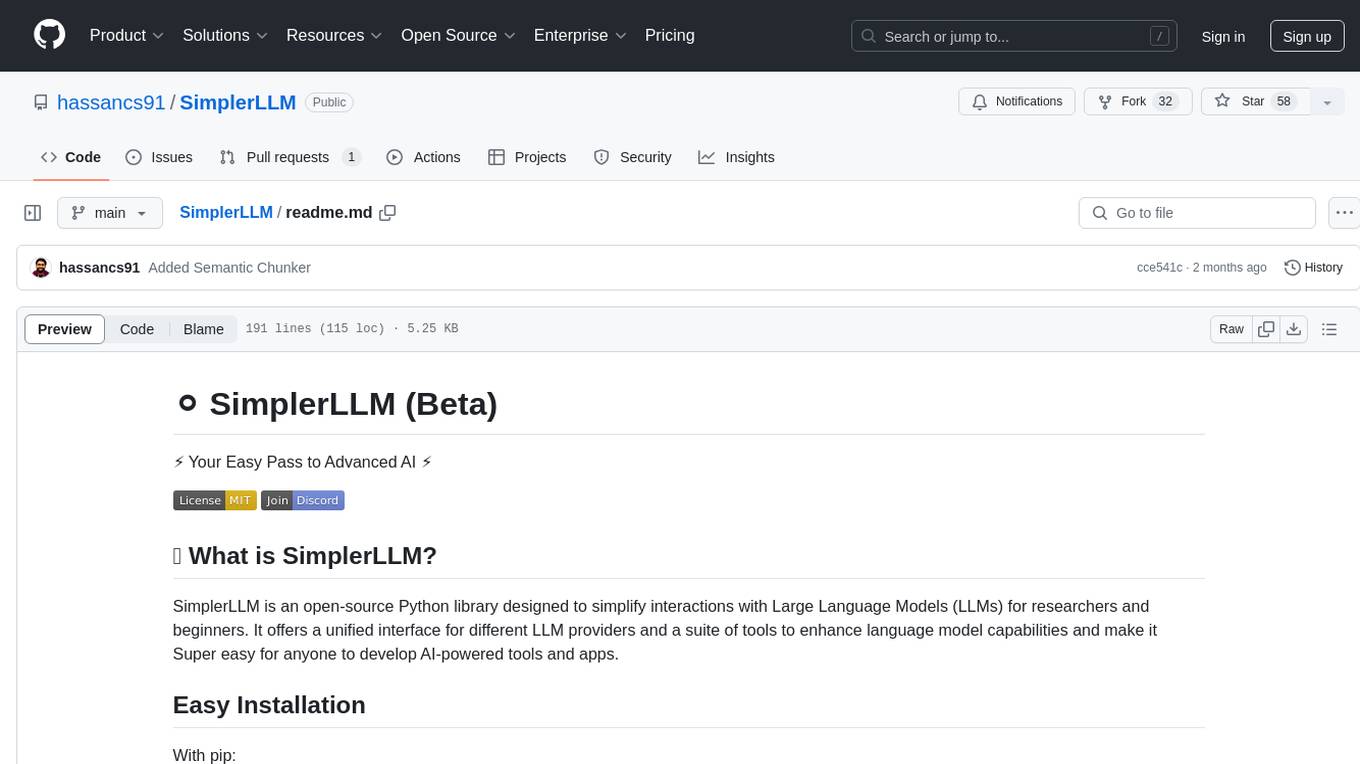
SimplerLLM
SimplerLLM is an open-source Python library that simplifies interactions with Large Language Models (LLMs) for researchers and beginners. It provides a unified interface for different LLM providers, tools for enhancing language model capabilities, and easy development of AI-powered tools and apps. The library offers features like unified LLM interface, generic text loader, RapidAPI connector, SERP integration, prompt template builder, and more. Users can easily set up environment variables, create LLM instances, use tools like SERP, generic text loader, calling RapidAPI APIs, and prompt template builder. Additionally, the library includes chunking functions to split texts into manageable chunks based on different criteria. Future updates will bring more tools, interactions with local LLMs, prompt optimization, response evaluation, GPT Trainer, document chunker, advanced document loader, integration with more providers, Simple RAG with SimplerVectors, integration with vector databases, agent builder, and LLM server.
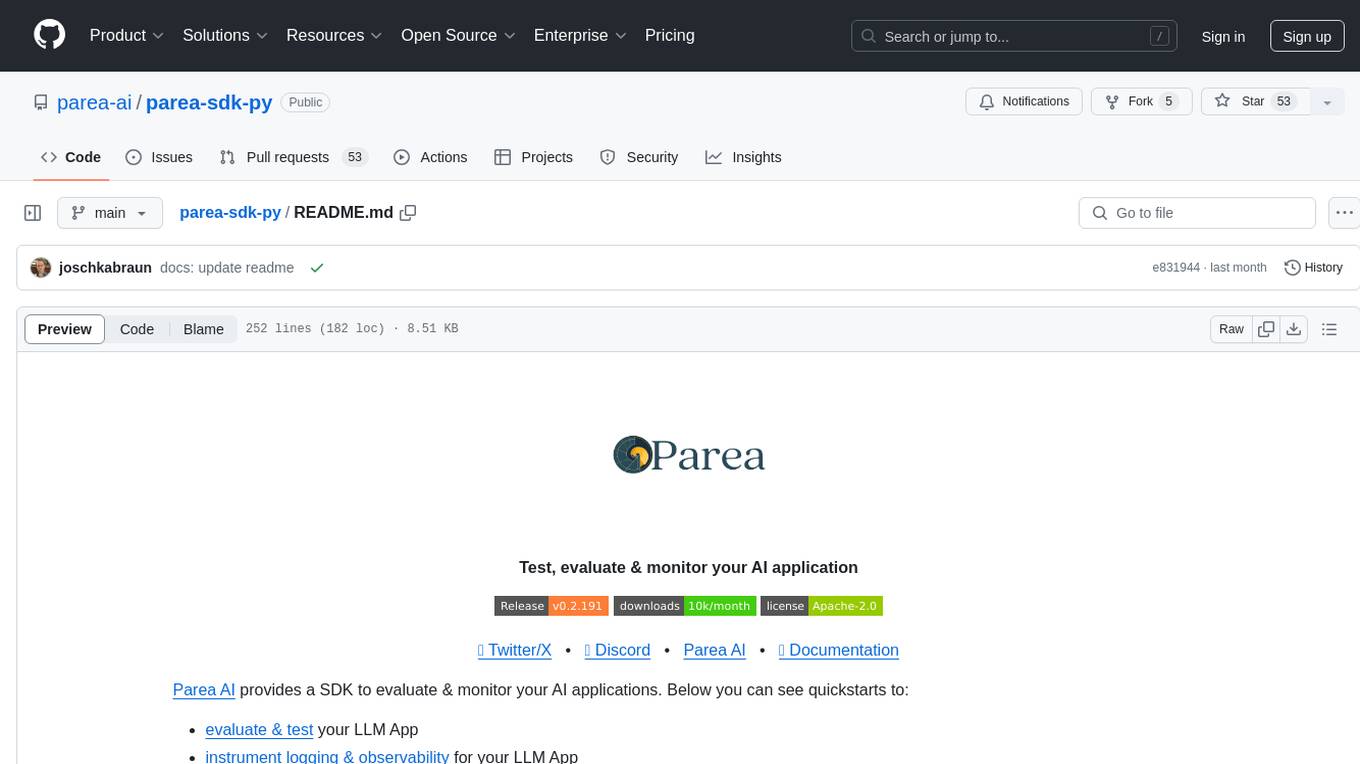
parea-sdk-py
Parea AI provides a SDK to evaluate & monitor AI applications. It allows users to test, evaluate, and monitor their AI models by defining and running experiments. The SDK also enables logging and observability for AI applications, as well as deploying prompts to facilitate collaboration between engineers and subject-matter experts. Users can automatically log calls to OpenAI and Anthropic, create hierarchical traces of their applications, and deploy prompts for integration into their applications.
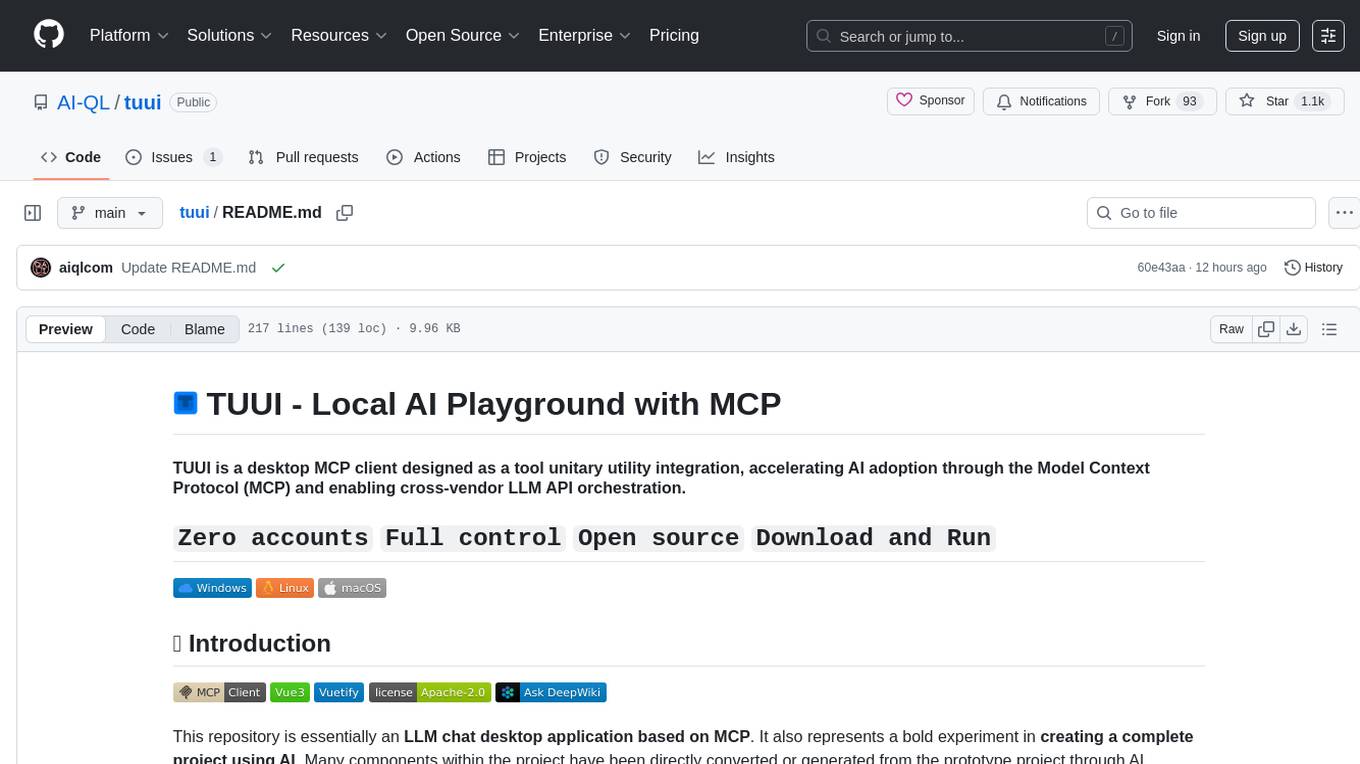
tuui
TUUI is a desktop MCP client designed for accelerating AI adoption through the Model Context Protocol (MCP) and enabling cross-vendor LLM API orchestration. It is an LLM chat desktop application based on MCP, created using AI-generated components with strict syntax checks and naming conventions. The tool integrates AI tools via MCP, orchestrates LLM APIs, supports automated application testing, TypeScript, multilingual, layout management, global state management, and offers quick support through the GitHub community and official documentation.
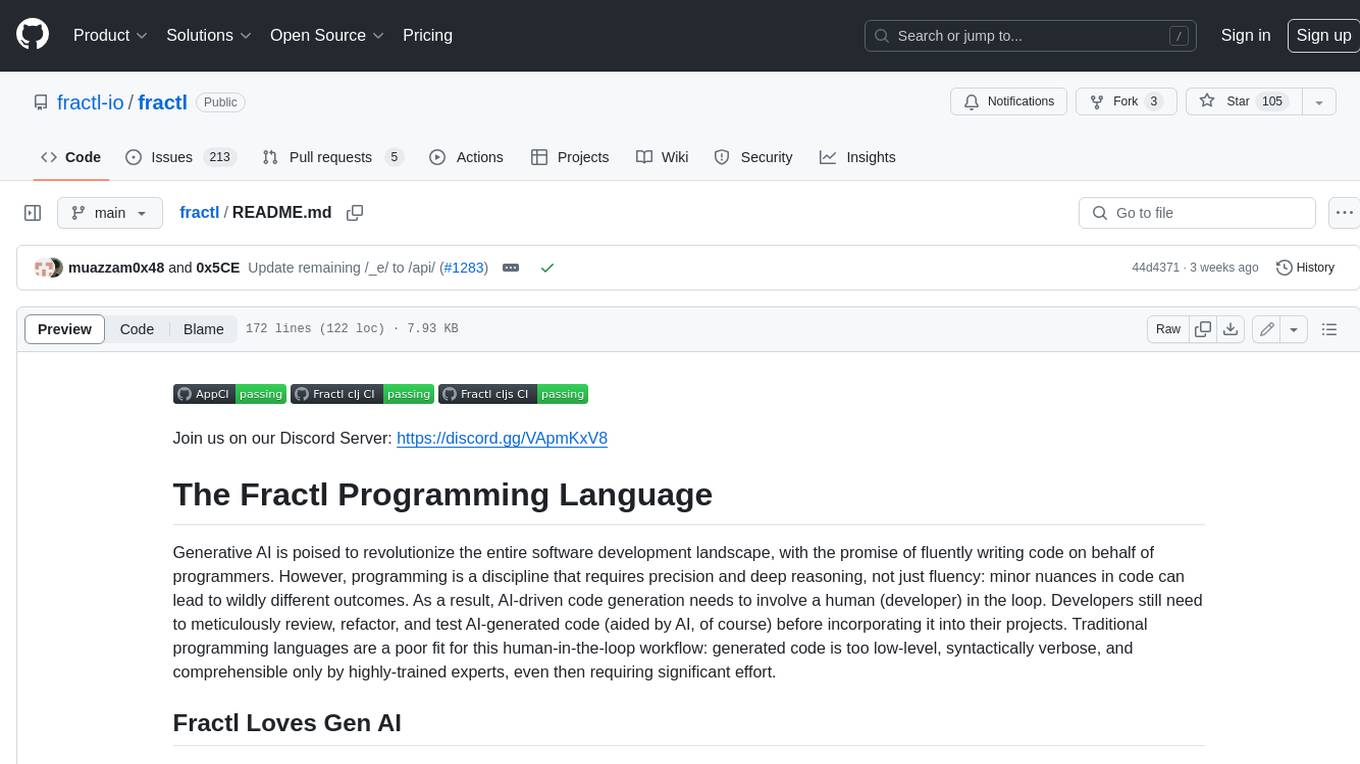
fractl
Fractl is a programming language designed for generative AI, making it easier for developers to work with AI-generated code. It features a data-oriented and declarative syntax, making it a better fit for generative AI-powered code generation. Fractl also bridges the gap between traditional programming and visual building, allowing developers to use multiple ways of building, including traditional coding, visual development, and code generation with generative AI. Key concepts in Fractl include a graph-based hierarchical data model, zero-trust programming, declarative dataflow, resolvers, interceptors, and entity-graph-database mapping.
For similar tasks

redisvl
Redis Vector Library (RedisVL) is a Python client library for building AI applications on top of Redis. It provides a high-level interface for managing vector indexes, performing vector search, and integrating with popular embedding models and providers. RedisVL is designed to make it easy for developers to build and deploy AI applications that leverage the speed, flexibility, and reliability of Redis.
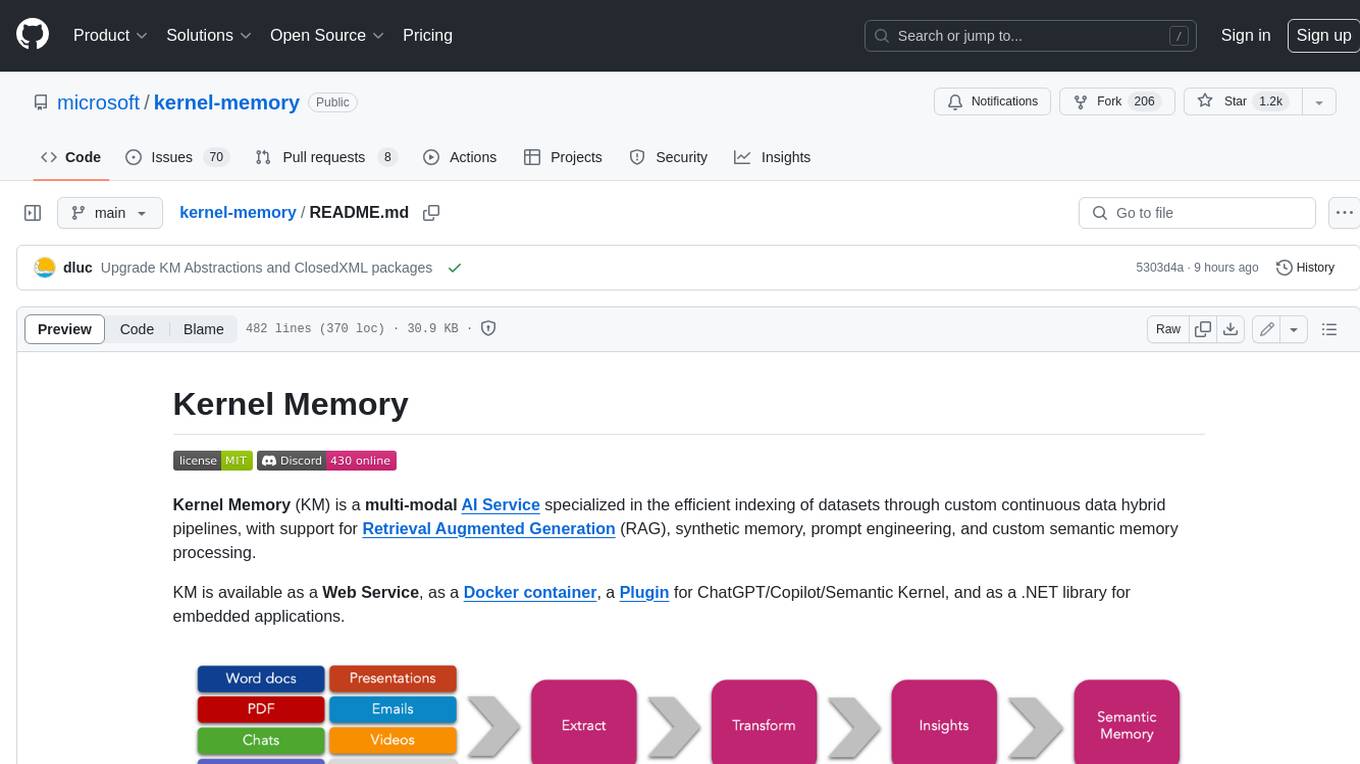
kernel-memory
Kernel Memory (KM) is a multi-modal AI Service specialized in the efficient indexing of datasets through custom continuous data hybrid pipelines, with support for Retrieval Augmented Generation (RAG), synthetic memory, prompt engineering, and custom semantic memory processing. KM is available as a Web Service, as a Docker container, a Plugin for ChatGPT/Copilot/Semantic Kernel, and as a .NET library for embedded applications. Utilizing advanced embeddings and LLMs, the system enables Natural Language querying for obtaining answers from the indexed data, complete with citations and links to the original sources. Designed for seamless integration as a Plugin with Semantic Kernel, Microsoft Copilot and ChatGPT, Kernel Memory enhances data-driven features in applications built for most popular AI platforms.
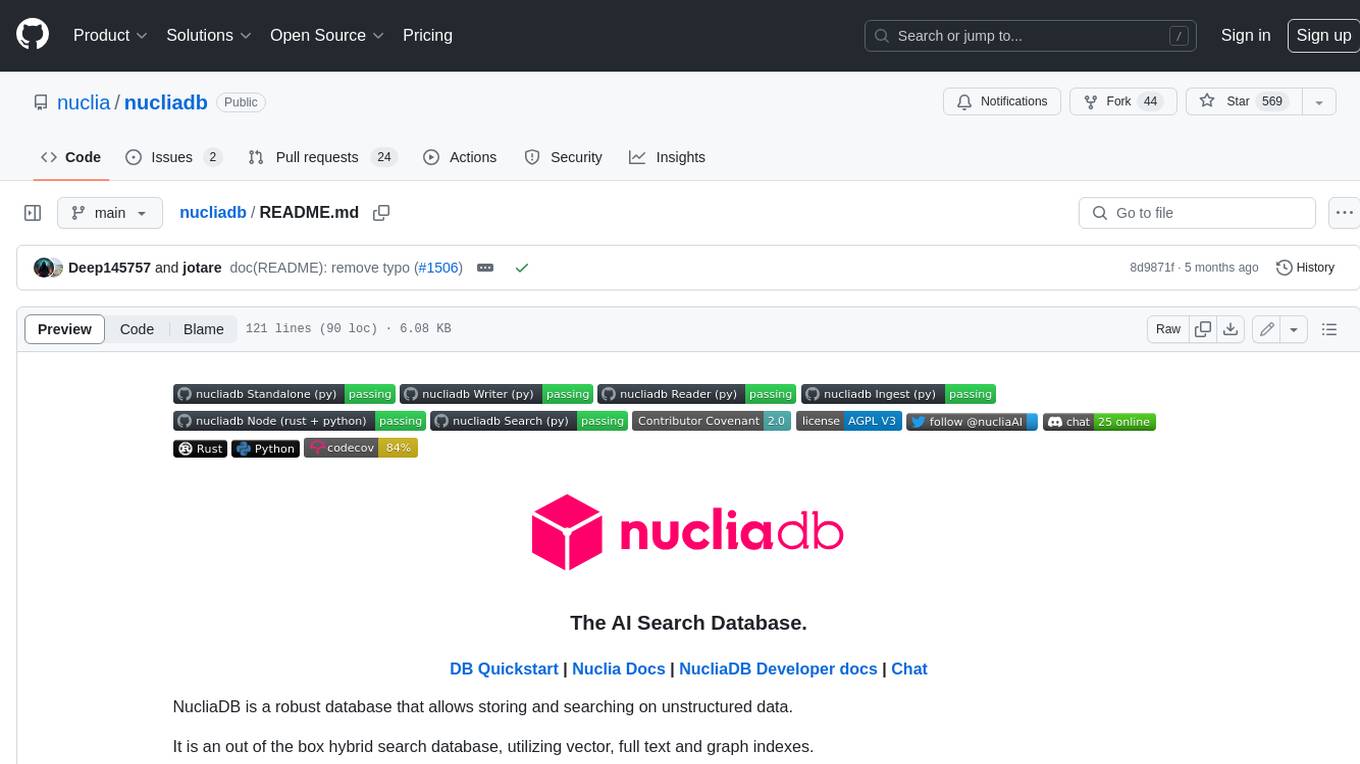
nucliadb
NucliaDB is a robust database that allows storing and searching on unstructured data. It is an out of the box hybrid search database, utilizing vector, full text and graph indexes. NucliaDB is written in Rust and Python. We designed it to index large datasets and provide multi-teanant support. When utilizing NucliaDB with Nuclia cloud, you are able to the power of an NLP database without the hassle of data extraction, enrichment and inference. We do all the hard work for you.
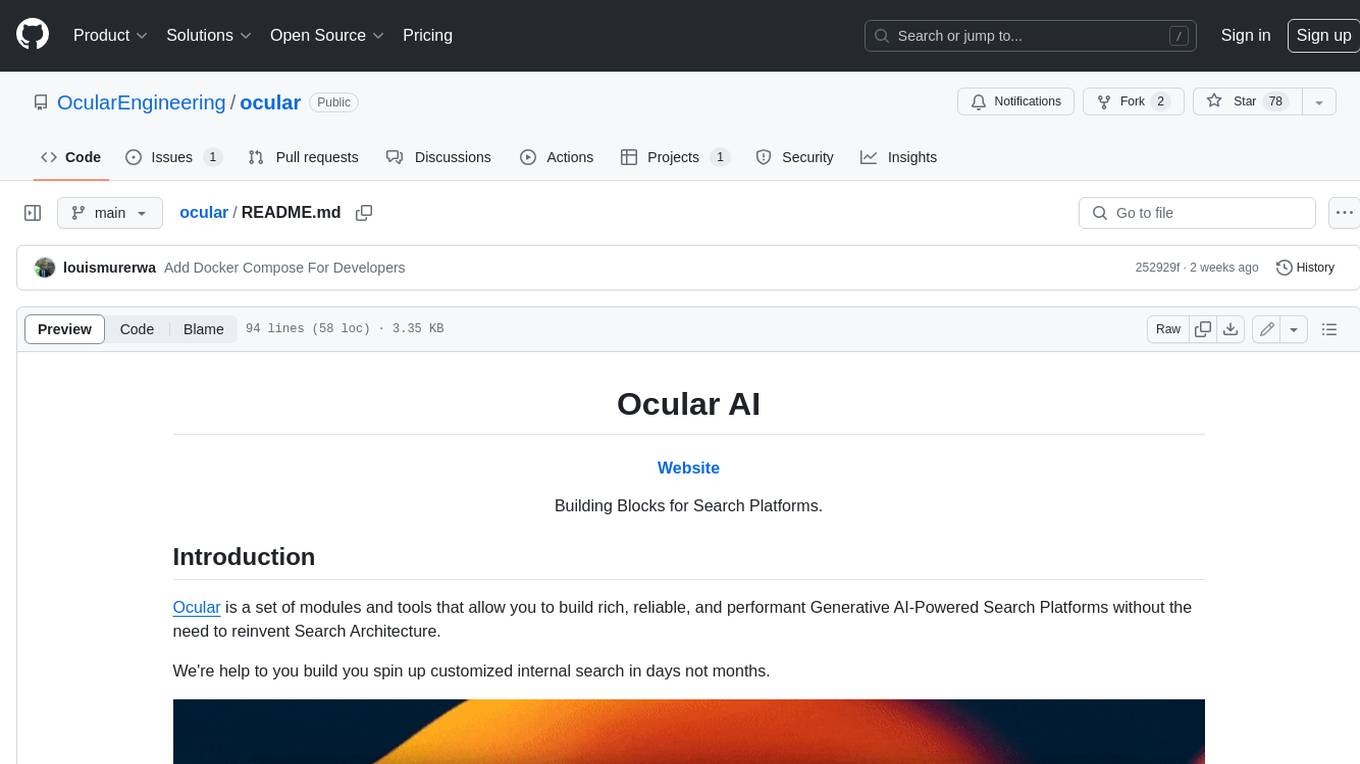
ocular
Ocular is a set of modules and tools that allow you to build rich, reliable, and performant Generative AI-Powered Search Platforms without the need to reinvent Search Architecture. We help you build you spin up customized internal search in days not months.
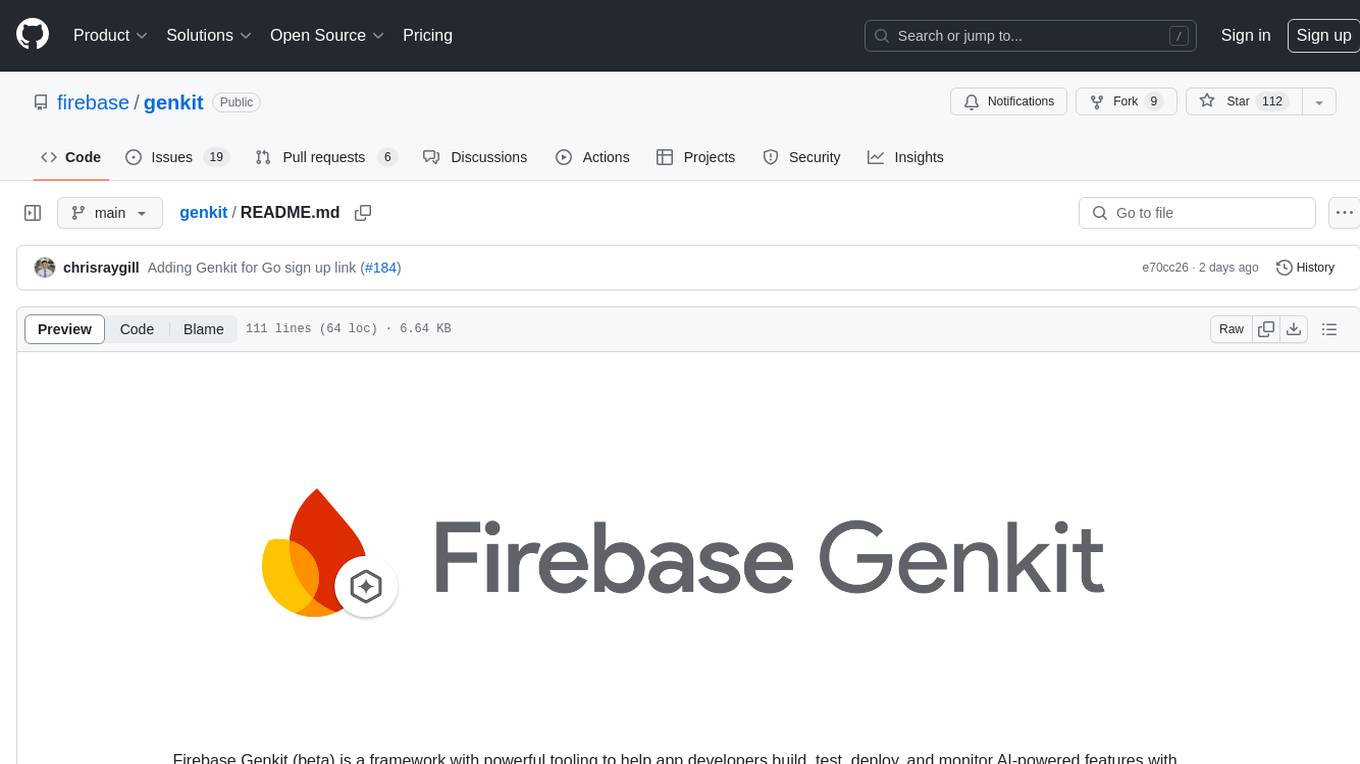
genkit
Firebase Genkit (beta) is a framework with powerful tooling to help app developers build, test, deploy, and monitor AI-powered features with confidence. Genkit is cloud optimized and code-centric, integrating with many services that have free tiers to get started. It provides unified API for generation, context-aware AI features, evaluation of AI workflow, extensibility with plugins, easy deployment to Firebase or Google Cloud, observability and monitoring with OpenTelemetry, and a developer UI for prototyping and testing AI features locally. Genkit works seamlessly with Firebase or Google Cloud projects through official plugins and templates.
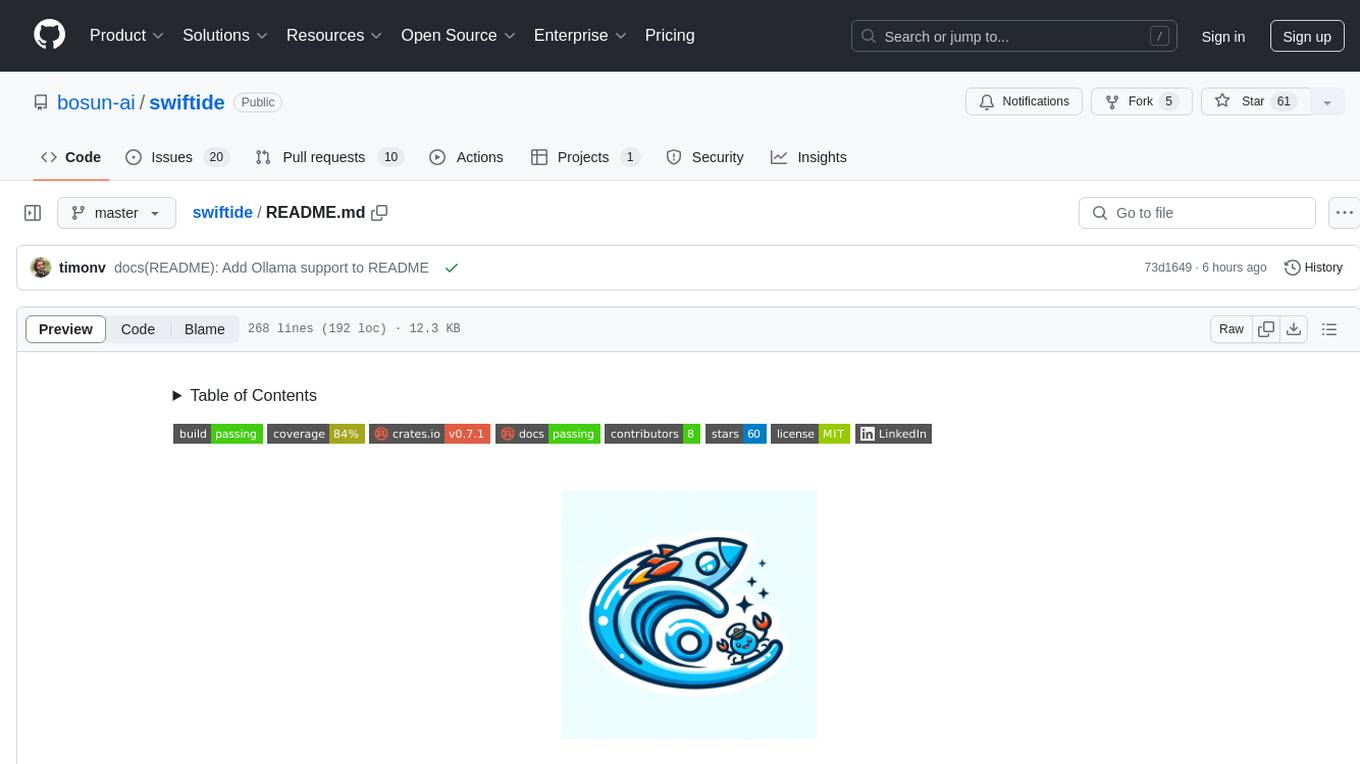
swiftide
Swiftide is a fast, streaming indexing and query library tailored for Retrieval Augmented Generation (RAG) in AI applications. It is built in Rust, utilizing parallel, asynchronous streams for blazingly fast performance. With Swiftide, users can easily build AI applications from idea to production in just a few lines of code. The tool addresses frustrations around performance, stability, and ease of use encountered while working with Python-based tooling. It offers features like fast streaming indexing pipeline, experimental query pipeline, integrations with various platforms, loaders, transformers, chunkers, embedders, and more. Swiftide aims to provide a platform for data indexing and querying to advance the development of automated Large Language Model (LLM) applications.
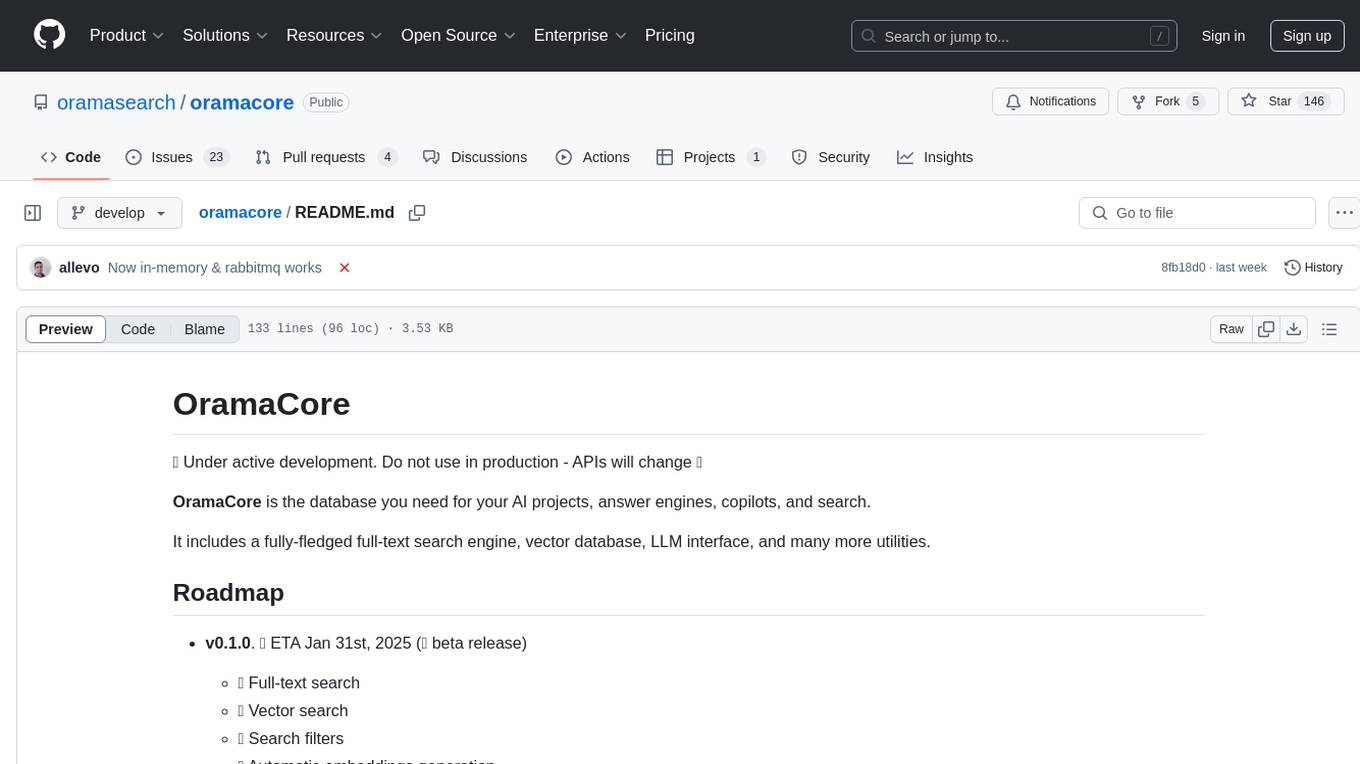
oramacore
OramaCore is a database designed for AI projects, answer engines, copilots, and search functionalities. It offers features such as a full-text search engine, vector database, LLM interface, and various utilities. The tool is currently under active development and not recommended for production use due to potential API changes. OramaCore aims to provide a comprehensive solution for managing data and enabling advanced search capabilities in AI applications.
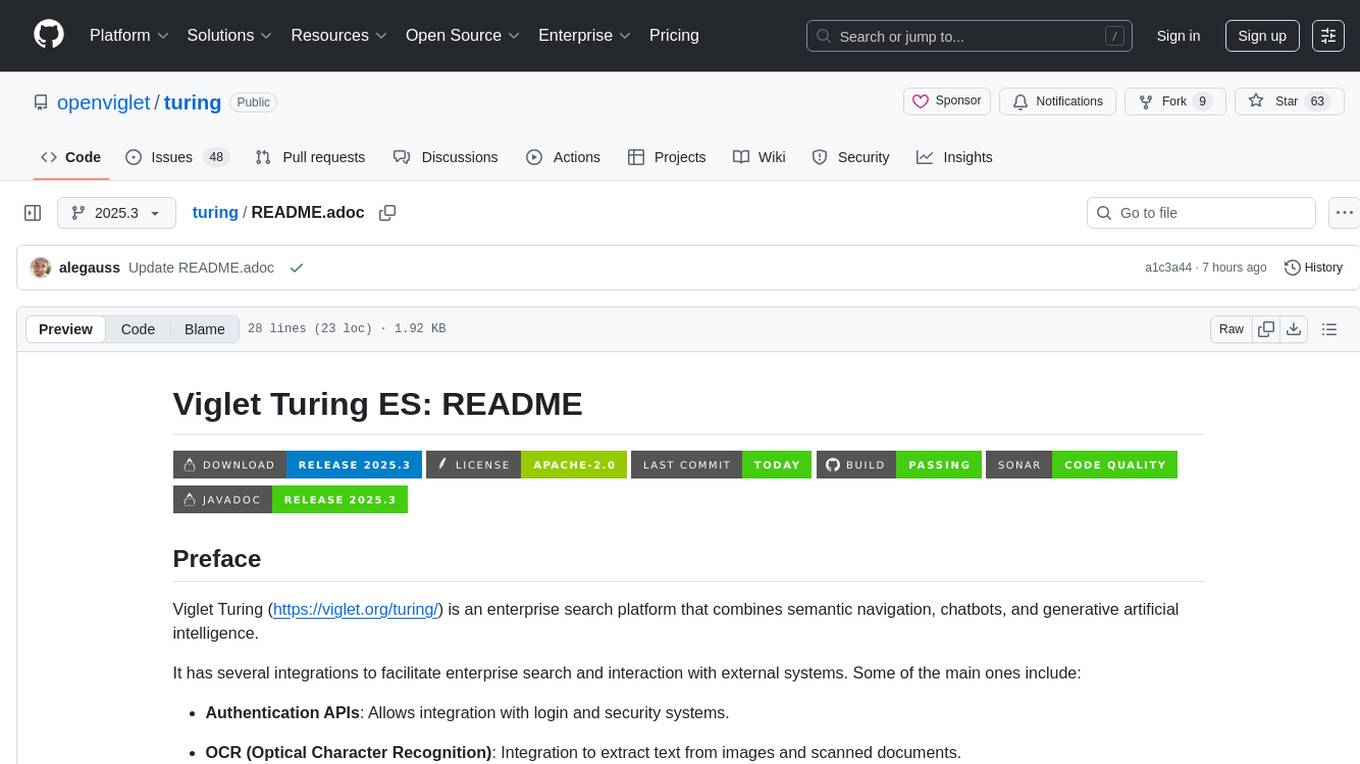
turing
Viglet Turing is an enterprise search platform that combines semantic navigation, chatbots, and generative artificial intelligence. It offers integrations for authentication APIs, OCR, content indexing, CMS connectors, web crawling, database connectors, and file system indexing.
For similar jobs

sweep
Sweep is an AI junior developer that turns bugs and feature requests into code changes. It automatically handles developer experience improvements like adding type hints and improving test coverage.

teams-ai
The Teams AI Library is a software development kit (SDK) that helps developers create bots that can interact with Teams and Microsoft 365 applications. It is built on top of the Bot Framework SDK and simplifies the process of developing bots that interact with Teams' artificial intelligence capabilities. The SDK is available for JavaScript/TypeScript, .NET, and Python.

ai-guide
This guide is dedicated to Large Language Models (LLMs) that you can run on your home computer. It assumes your PC is a lower-end, non-gaming setup.

classifai
Supercharge WordPress Content Workflows and Engagement with Artificial Intelligence. Tap into leading cloud-based services like OpenAI, Microsoft Azure AI, Google Gemini and IBM Watson to augment your WordPress-powered websites. Publish content faster while improving SEO performance and increasing audience engagement. ClassifAI integrates Artificial Intelligence and Machine Learning technologies to lighten your workload and eliminate tedious tasks, giving you more time to create original content that matters.

chatbot-ui
Chatbot UI is an open-source AI chat app that allows users to create and deploy their own AI chatbots. It is easy to use and can be customized to fit any need. Chatbot UI is perfect for businesses, developers, and anyone who wants to create a chatbot.

BricksLLM
BricksLLM is a cloud native AI gateway written in Go. Currently, it provides native support for OpenAI, Anthropic, Azure OpenAI and vLLM. BricksLLM aims to provide enterprise level infrastructure that can power any LLM production use cases. Here are some use cases for BricksLLM: * Set LLM usage limits for users on different pricing tiers * Track LLM usage on a per user and per organization basis * Block or redact requests containing PIIs * Improve LLM reliability with failovers, retries and caching * Distribute API keys with rate limits and cost limits for internal development/production use cases * Distribute API keys with rate limits and cost limits for students

uAgents
uAgents is a Python library developed by Fetch.ai that allows for the creation of autonomous AI agents. These agents can perform various tasks on a schedule or take action on various events. uAgents are easy to create and manage, and they are connected to a fast-growing network of other uAgents. They are also secure, with cryptographically secured messages and wallets.

griptape
Griptape is a modular Python framework for building AI-powered applications that securely connect to your enterprise data and APIs. It offers developers the ability to maintain control and flexibility at every step. Griptape's core components include Structures (Agents, Pipelines, and Workflows), Tasks, Tools, Memory (Conversation Memory, Task Memory, and Meta Memory), Drivers (Prompt and Embedding Drivers, Vector Store Drivers, Image Generation Drivers, Image Query Drivers, SQL Drivers, Web Scraper Drivers, and Conversation Memory Drivers), Engines (Query Engines, Extraction Engines, Summary Engines, Image Generation Engines, and Image Query Engines), and additional components (Rulesets, Loaders, Artifacts, Chunkers, and Tokenizers). Griptape enables developers to create AI-powered applications with ease and efficiency.





